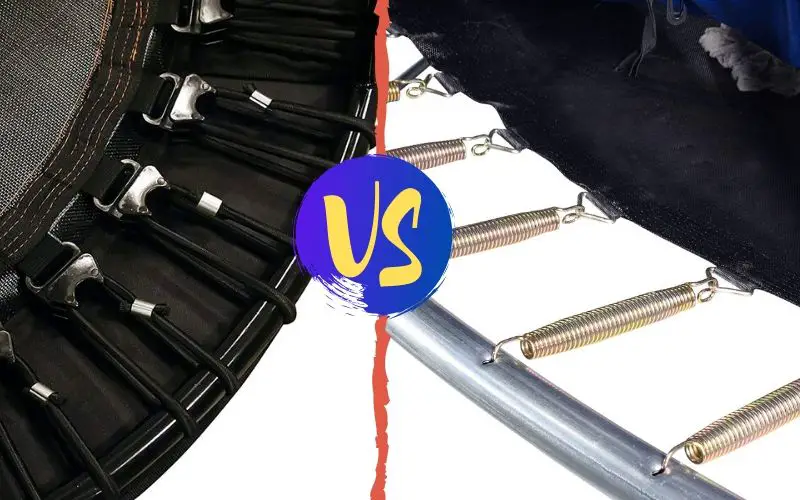If you’re looking to get a blow by blow comparison between springless vs spring trampolines, you’ll definitely find the information here.
Aside from picking the right size and shape, you also need to consider if you should get one with elastic bands or one with spring.
Being able to intelligently choose which one of these will help you achieve your goal while sparing you from the hassle of disappointment and returns. You’ll also be able to get your money’s worth because you’ll get a more rewarding experience.
Springless vs Spring Trampoline
There are many ways to categorize a trampoline. You can do this by shape, by size, or by purpose. You’ll also need to consider above-ground and in-ground trampoline options. However, within each of these categories are types of design that will greatly affect your experience.
To better understand the difference between springless vs spring trampolines, I’ll be matching them side by side based on these 4 primary factors: materials, setup or installation, safety, and jumping experience.
Materials
A spring-based trampoline has galvanized and rust-proof springs to power every jump. On the other hand, springless types make use of bungee cords or elastic bands. In general, springs are less likely to break than elastic bands.
However, not all springs are truly rust-proof. Some tend to get brittle as they remain exposed outside. This usually happens if you end up picking the wrong brand.
With springless, you get either a bungee cord or elastic bands. Obviously, this type of material will never get any rust at all. Some questionable brands have elastic bands that snap after several weeks of use only. Compared to spring types, you’ll still be able to safely use your trampoline even if a cord breaks (although we recommend you order a replacement as soon as this happens).
Setup
Most springless trampolines require almost no setup when you receive them. The bands are already installed and looped around the frame. If you end up choosing this type, you need to get one that has bands that can be replaced. Poorly made ones usually have the bands sewn directly to the mat, which prevents you from replacing a snapped cord.
Spring types always require setting up. You’ll need to hook each spring from the net to the holes on the frame. This usually requires some effort as you’ll need to pull each spring so that the jumping mat doesn’t sag.
Safety
When it comes to safety, springless models are a lot better. The most common injuries one gets from a trampoline is pinched fingers. This usually happens when your foot or hands accidentally slip under the protective cover, hitting the springs.
Springs are also more dangerous when they break compared to bungee cords. There are trampoline brands that separate the spring completely from the jumper to make it safer, at the cost of smaller jumping surface like the Skywalker 15 Inch trampoline.
Since there’s zero possibility of pinched injuries on springless trampolines, there’s always a bigger jumping area. Manufacturers can confidently just add some covering on top of the elastic bands and it can be used as part of the jumping surface.
Bounce Quality
The jump experience is not always the same for everyone. Some want a firmer bounce while others want a bouncier trampoline. Trampolines with springs are a lot bouncier than those with bungee cords. It’s the same reason why you’ll only find spring-based trampolines in gymnastic competitions (and even those used in the circus).
When you land on this type of trampoline after jumping, Get ready to be propelled higher. this means that you can perform aerial stunts like backflips or somersaults easily.
Trampolines with bungee cords have a firmer bounce than. It may seem to be ironic since bungee cords have an amazing elasticity as experienced with bungee jumping. However, the cords will need to be extended longer to achieve this. This means more space will need to be occupied by the trampoline and higher distance between the mat and the floor.
Springless trampolines are mostly designed for fitness and as a child’s toy so a firm bouncing experience is the goal of this type.
Springfree Trampoline Brand
When it comes to design and safety, Springfree brand is something worth checking out. It has an unconventional design that adds safety without compromising the size of the jump area.
Instead of elastic bands or springs, they make use of fiberglass rods to power every jump on their trampolines. These rods are situated at the bottom perimeter underneath the jump area.
You get a larger area to jump without fear of hitting the springs and you also get to experience the same bounce quality as that of spring-based trampolines.
At the time of this writing, they’re only available as backyard trampolines because of their large size.
Wrapping It Up
In the end, choosing between springless vs spring trampoline will depend on your priorities and preference. If you’re looking to get one for fitness purposes, you’ll need springless models that have firmer bounce. If, on the other hand, your preference is to jump higher to perform somersaults you’ll need spring types.
Be sure to check our recommendations of the best trampolines in the market today, if you’re looking for high-quality models.


Great! Very helpful information that helped me assess the pros and cons of each type; I now know that the spring-free elastic-cord style trampoline is the best, safest, and most appropriate choice for my 3 year old’s first trampoline. Her birthday is next week so I’m grateful to have found your website!
Thanks so much from Australia 🇦🇺!
Cheers,
Suzy.